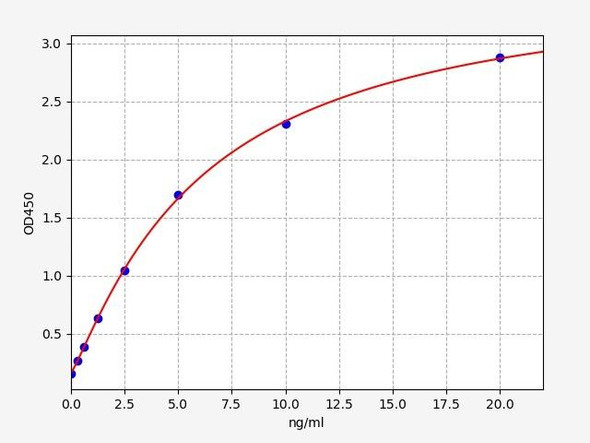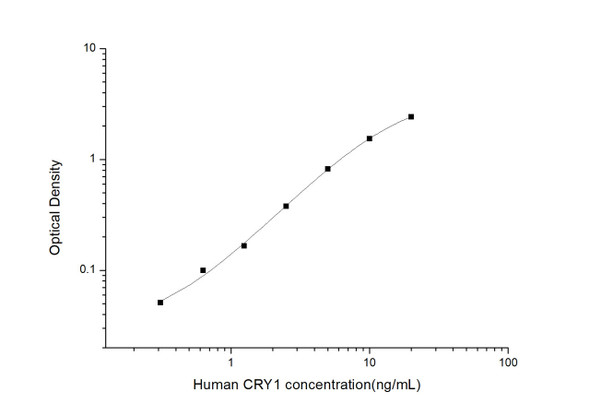Human Cell Biology ELISA Kits 5
Human CRY1 (Cryptochrome 1) CLIA Kit (HUES01181)
- SKU:
- HUES01181
- Product Type:
- ELISA Kit
- ELISA Type:
- CLIA Kit
- Size:
- 96 Assays
- Sensitivity:
- 37.5pg/mL
- Range:
- 62.5-4000pg/mL
- ELISA Type:
- Sandwich
- Reactivity:
- Human
- Sample Type:
- Serum, plasma and other biological fluids
- Research Area:
- Cell Biology
Description
| Assay type: | Sandwich |
| Format: | 96T |
| Assay time: | 4.5h |
| Reactivity: | Human |
| Detection method: | Chemiluminescence |
| Detection range: | 62.50-4000 pg/mL |
| Sensitivity: | 37.50 pg/mL |
| Sample volume: | 100µL |
| Sample type: | Serum, plasma and other biological fluids |
| Repeatability: | CV < 15% |
| Specificity: | This kit recognizes Human CRY1 in samples. No significant cross-reactivity or interference between Human CRY1 and analogues was observed. |
This kit uses Sandwich-CLIA as the method. The micro CLIA plate provided in this kit has been pre-coated with an antibody specific to Human CRY1. Standards or samples are added to the appropriate micro CLIA plate wells and combined with the specific antibody. Then a biotinylated detection antibody specific for Human CRY1 and Avidin-Horseradish Peroxidase (HRP) conjugate are added to each micro plate well successively and incubated. Free components are washed away. The substrate solution is added to each well. Only those wells that contain Human CRY1, biotinylated detection antibody and Avidin-HRP conjugate will appear fluorescence. The Relative light unit (RLU) value is measured spectrophotometrically by the Chemiluminescence immunoassay analyzer. The RLU value is positively associated with the concentration of Human CRY1. The concentration of Human CRY1 in the samples can be calculated by comparing the RLU of the samples to the standard curve.
| UniProt Protein Function: | CRY1: Blue light-dependent regulator of the circadian feedback loop. Inhibits CLOCK|NPAS2-ARNTL E box-mediated transcription. Acts, in conjunction with CRY2, in maintaining period length and circadian rhythmicity. Has no photolyase activity. Capable of translocating circadian clock core proteins such as PER proteins to the nucleus. May inhibit CLOCK|NPAS2-ARNTL transcriptional activity through stabilizing the unphosphorylated form of ARNTL. Component of the circadian core oscillator, which includes the CRY proteins, CLOCK or NPAS2, ARNTL or ARNTL2, CSNK1D and/or CSNK1E, TIMELESS, and the PER proteins. Interacts directly with TIMELESS and the PER proteins. Interacts directly with PER1 and PER2 C-terminal domains. Interaction with PER2 inhibits its ubiquitination and vice versa. Binds MAPK. Interacts with FBXL21. Interacts with FBXL3. Expression is regulated by light and circadian rhythms. Peak expression in the suprachiasma nucleus (SCN) and eye at the day/night transition (CT12). Levels decrease with ARNTL-CLOCK inhibition as part of the autoregulatory feedback loop. Belongs to the DNA photolyase class-1 family. |
| UniProt Protein Details: | Protein type:DNA-binding; Transcription, coactivator/corepressor; Lyase Chromosomal Location of Human Ortholog: 12q23-q24. 1 Cellular Component: mitochondrion; nucleus Molecular Function:ubiquitin binding; histone deacetylase binding; DNA (6-4) photolyase activity; nucleotide binding; transcription factor binding; protein kinase binding; phosphatase binding; protein binding; DNA binding; double-stranded DNA binding; deoxyribodipyrimidine photo-lyase activity; blue light photoreceptor activity; nuclear hormone receptor binding Biological Process: circadian rhythm; response to glucagon stimulus; transcription, DNA-dependent; DNA damage induced protein phosphorylation; negative regulation of G-protein coupled receptor protein signaling pathway; negative regulation of transcription from RNA polymerase II promoter; glucose homeostasis; DNA repair; regulation of circadian rhythm; protein-chromophore linkage; response to insulin stimulus; gluconeogenesis; entrainment of circadian clock by photoperiod; blue light signaling pathway; sequestering of lipid; negative regulation of circadian rhythm; negative regulation of protein ubiquitination; circadian regulation of gene expression; negative regulation of transcription, DNA-dependent |
| NCBI Summary: | This gene encodes a flavin adenine dinucleotide-binding protein that is a key component of the circadian core oscillator complex, which regulates the circadian clock. This gene is upregulated by CLOCK/ARNTL heterodimers but then represses this upregulation in a feedback loop using PER/CRY heterodimers to interact with CLOCK/ARNTL. Polymorphisms in this gene have been associated with altered sleep patterns. The encoded protein is widely conserved across plants and animals. Loss of the related gene in mouse results in a shortened circadian cycle in complete darkness. [provided by RefSeq, Jan 2014] |
| UniProt Code: | Q16526 |
| NCBI GenInfo Identifier: | 74735764 |
| NCBI Gene ID: | 1407 |
| NCBI Accession: | Q16526. 1 |
| UniProt Related Accession: | Q16526 |
| Molecular Weight: | 586 |
| NCBI Full Name: | Cryptochrome-1 |
| NCBI Synonym Full Names: | cryptochrome circadian clock 1 |
| NCBI Official Symbol: | CRY1 |
| NCBI Official Synonym Symbols: | PHLL1 |
| NCBI Protein Information: | cryptochrome-1; cryptochrome 1 (photolyase-like) |
| UniProt Protein Name: | Cryptochrome-1 |
| Protein Family: | Cryptochrome |
| UniProt Gene Name: | CRY1 |
| UniProt Entry Name: | CRY1_HUMAN |
As the RLU values of the standard curve may vary according to the conditions of the actual assay performance (e. g. operator, pipetting technique, washing technique or temperature effects), the operator should establish a standard curve for each test. Typical standard curve and data is provided below for reference only.
| Concentration (pg/mL) | RLU | Average | Corrected |
| 4000 | 58424 59738 | 59081 | 59046 |
| 2000 | 26882 28836 | 27859 | 27824 |
| 1000 | 14587 12381 | 13484 | 13449 |
| 500 | 6171 7039 | 6605 | 6570 |
| 250 | 3401 3085 | 3243 | 3208 |
| 125 | 1639 1523 | 1581 | 1546 |
| 62.50 | 724 786 | 755 | 720 |
| 0 | 35 35 | 35 | -- |
Precision
Intra-assay Precision (Precision within an assay): 3 samples with low, mid range and high level Human CRY1 were tested 20 times on one plate, respectively.
Inter-assay Precision (Precision between assays): 3 samples with low, mid range and high level Human CRY1 were tested on 3 different plates, 20 replicates in each plate.
| Intra-assay Precision | Inter-assay Precision | |||||
| Sample | 1 | 2 | 3 | 1 | 2 | 3 |
| n | 20 | 20 | 20 | 20 | 20 | 20 |
| Mean (pg/mL) | 197.24 | 373.59 | 1618.13 | 204.52 | 358.69 | 1504.24 |
| Standard deviation | 23.61 | 43.07 | 181.07 | 22.11 | 39.78 | 109.81 |
| C V (%) | 11.97 | 11.53 | 11.19 | 10.81 | 11.09 | 7.30 |
Recovery
The recovery of Human CRY1 spiked at three different levels in samples throughout the range of the assay was evaluated in various matrices.
| Sample Type | Range (%) | Average Recovery (%) |
| Serum (n=5) | 98-114 | 105 |
| EDTA plasma (n=5) | 89-101 | 94 |
| Cell culture media (n=5) | 97-114 | 105 |
Linearity
Samples were spiked with high concentrations of Human CRY1 and diluted with Reference Standard & Sample Diluent to produce samples with values within the range of the assay.
| Serum (n=5) | EDTA plasma (n=5) | Cell culture media (n=5) | ||
| 1:2 | Range (%) | 101-117 | 94-111 | 100-115 |
| Average (%) | 108 | 102 | 107 | |
| 1:4 | Range (%) | 95-110 | 93-105 | 85-99 |
| Average (%) | 102 | 100 | 91 | |
| 1:8 | Range (%) | 97-112 | 89-103 | 87-101 |
| Average (%) | 103 | 96 | 95 | |
| 1:16 | Range (%) | 94-109 | 94-107 | 86-102 |
| Average (%) | 101 | 101 | 93 |
An unopened kit can be stored at 4°C for 1 month. If the kit is not used within 1 month, store the items separately according to the following conditions once the kit is received.
| Item | Specifications | Storage |
| Micro CLIA Plate(Dismountable) | 8 wells ×12 strips | -20°C, 6 months |
| Reference Standard | 2 vials | |
| Concentrated Biotinylated Detection Ab (100×) | 1 vial, 120 µL | |
| Concentrated HRP Conjugate (100×) | 1 vial, 120 µL | -20°C(shading light), 6 months |
| Reference Standard & Sample Diluent | 1 vial, 20 mL | 4°C, 6 months |
| Biotinylated Detection Ab Diluent | 1 vial, 14 mL | |
| HRP Conjugate Diluent | 1 vial, 14 mL | |
| Concentrated Wash Buffer (25×) | 1 vial, 30 mL | |
| Substrate Reagent A | 1 vial, 5 mL | 4°C (shading light) |
| Substrate Reagent B | 1 vial, 5 mL | 4°C (shading light) |
| Plate Sealer | 5 pieces | |
| Product Description | 1 copy | |
| Certificate of Analysis | 1 copy |
- Set standard, test sample and control (zero) wells on the pre-coated plate and record theirpositions. It is recommended to measure each standard and sample in duplicate. Note: addall solutions to the bottom of the plate wells while avoiding contact with the well walls. Ensuresolutions do not foam when adding to the wells.
- Aliquot 100 µL of standard solutions into the standard wells.
- Add 100 µL of Sample / Standard dilution buffer into the control (zero) well.
- Add 100 µL of properly diluted sample (serum, plasma, tissue homogenates and otherbiological fluids. ) into test sample wells.
- Cover the plate with the sealer provided in the kit and incubate for 90 min at 37 °C.
- Aspirate the liquid from each well, do not wash. Immediately add 100 µL of BiotinylatedDetection Ab working solution to each well. Cover the plate with a plate seal and gently mix. Incubate for 1 hour at 37 °C.
- Aspirate or decant the solution from the plate and add 350 µL of wash buffer to each welland incubate for 1-2 minutes at room temperature. Aspirate the solution from each well andclap the plate on absorbent filter paper to dry. Repeat this process 3 times. Note: a microplatewasher can be used in this step and other wash steps.
- Add 100 µL of HRP Conjugate working solution to each well. Cover with a plate seal andincubate for 30 min at 37 °C.
- Aspirate or decant the solution from each well. Repeat the wash process for five times asconducted in step 7.
- Add 100 µL of Substrate mixture solution to each well. Cover with a new plate seal andincubate for no more than 5 min at 37 °C. Protect the plate from light.
- Determine the RLU value of each well immediately.






